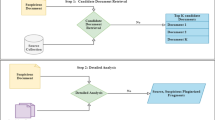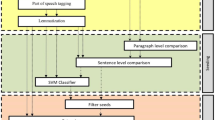Abstract
The sliding window concept is a common method for computing a profile of a document with unknown structure. This paper outlines an experiment with stylometric word-based feature in order to determine an optimal size of the sliding window. It was conducted for a vocabulary richness method called ’average word frequency class’ using the PAN 2015 source retrieval training corpus for plagiarism detection. The paper shows the pros and cons of the stop words removal for the sliding window document profiling and discusses the utilization of the selected feature for intrinsic plagiarism detection. The experiment resulted in the recommendation of setting the sliding windows to around 100 words in length for computing the text profile using the average word frequency class stylometric feature.
Access this chapter
Tax calculation will be finalised at checkout
Purchases are for personal use only
Preview
Unable to display preview. Download preview PDF.
Similar content being viewed by others
References
Kasprzak, J., Brandejs, M., Křipač, M.: Finding Plagiarism by Evaluating Document Similarities. In: Hersh, B., Callan, J., Maarek, Y., Sanderson, M. (eds.) SEPLN 2009 Workshop on Uncovering Plagiarism, Authorship and Social Software Misuse, pp. 24–28. CEUR Workshop Proceedings, August 2009
Koppel, M., Schler, J.: Authorship Verification as a One-class Classification Problem. In: Proceedings of the Twenty-First International Conference on Machine Learning (ICML 2004), Banff, Alberta, Canada, July 4–8 (2004)
Meyer zu Eissen, S., Stein, B., Kulig, M.: Plagiarism Detection Without Reference Collections. In: Advances in Data Analysis, Proceedings of the 30th Annual Conference of the Gesellschaft für Klassifikation e.V., Freie Universität Berlin, pp. 359–366 (2006)
Potthast, M., Hagen, M., Beyer, A., Busse, M., Tippmann, M., Rosso, P., Stein, B.: Overview of the 6th International Competition on Plagiarism Detection. In: Working Notes for CLEF 2014 Conference, Sheffield, UK, September 15–18, pp. 845–876 (2014)
Potthast, M., Hagen, M., Völske, M., Stein, B.: Crowdsourcing Interaction Logs to Understand Text Reuse from the Web. In: ACL (1), pp. 1212–1221. The Association for Computer Linguistics (2013)
Stamatatos, E.: A Survey of Modern Authorship Attribution Methods. Journal of the American Society for Information Science and Technology 60(3), 538–556 (2009)
Stamatatos, E.: Intrinsic Plagiarism Detection Using Character n-gram Profiles. In: Proceedings of the SEPLN 2009 Workshop on Uncovering Plagiarism, Authorship and Social Software Misuse, pp. 38–46 (2009)
Stamatatos, E., Daelemans, W., Verhoeven, B., Stein, B., Potthast, M., Juola, P., Sánchez-Pérez, M.A., Barrón-Cedeño, A.: Overview of the Author Identification Task at PAN 2014. In: Working Notes for CLEF 2014 Conference, Sheffield, UK, September 15–18, pp. 877–897 (2014)
Stein, B., Lipka, N., Prettenhofer, P.: Intrinsic Plagiarism Analysis. Language Resources and Evaluation 45(1), 63–82 (2011)
Stein, B., Meyer zu Eissen, S.: Intrinsic Plagiarism Analysis with Meta Learning. In: Proceedings of the SIGIR 2007 International Workshop on Plagiarism Analysis, Authorship Identification, and Near-Duplicate Detection, Amsterdam, Netherlands, July 27 (2007)
Suchomel, Š., Brandejs, M.: Approaches for Candidate Document Retrieval. In: 2014 5th International Conference on Information and Communication Systems (ICICS), pp. 1–6. IEEE, Irbid (2014)
Suchomel, Š., Kasprzak, J., Brandejs, M.: Three Way Search Engine Queries with Multi-feature Document Comparison for Plagiarism Detection. In: CLEF 2012 Evaluation Labs and Workshop, Online Working Notes, Rome, Italy (2012)
Author information
Authors and Affiliations
Corresponding author
Editor information
Editors and Affiliations
Rights and permissions
Copyright information
© 2015 Springer International Publishing Switzerland
About this paper
Cite this paper
Suchomel, Š., Brandejs, M. (2015). Determining Window Size from Plagiarism Corpus for Stylometric Features. In: Mothe, J., et al. Experimental IR Meets Multilinguality, Multimodality, and Interaction. CLEF 2015. Lecture Notes in Computer Science(), vol 9283. Springer, Cham. https://doi.org/10.1007/978-3-319-24027-5_31
Download citation
DOI: https://doi.org/10.1007/978-3-319-24027-5_31
Published:
Publisher Name: Springer, Cham
Print ISBN: 978-3-319-24026-8
Online ISBN: 978-3-319-24027-5
eBook Packages: Computer ScienceComputer Science (R0)




